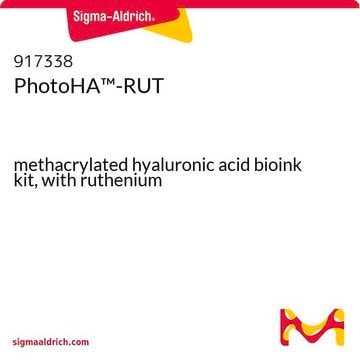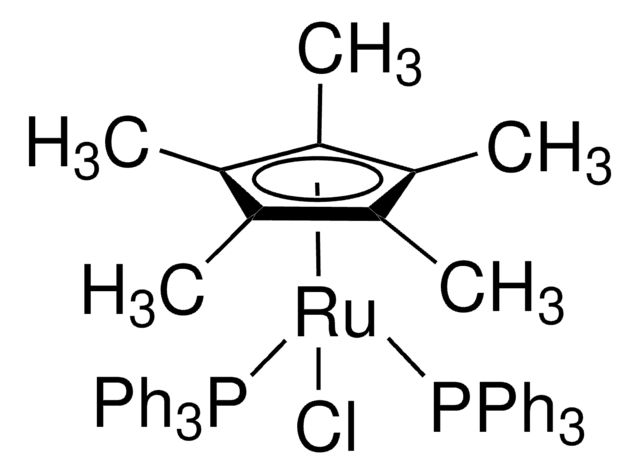추천 제품
구성
Ruthenium (200 mg)
Sodium persulfate photoinitiator (1 g)
Quality Level
애플리케이션
Ruthenium is a photoinitiator that utilizes visible light photocrosslinking (400-450nm) to covalently crosslink free tyrosine and acryl groups. Ruthenium photoinitiator has been tested on collagen type I, gelatin, silk fibroin, methacrylated hyaluronic acid, methacrylated gelatin, methacrylated collagen type I and PEGDA. Ruthenium is water soluble and yields better cytocompatibility, and crosslinking efficiency. Ruthenium is red/yellow/orange in color and will change the color of your solutions, hydrogels, or printed constructs. The Ruthenium photoinitiator kit is non-sterile. Adding antibiotics to your cell culture system, or sterile filtering is recommended. To sterile filter, resuspend the entire volume of ruthenium and Sodium persulfate (separately) and filter through small 0.2 micron button filters (separately). Use the sterile photoinitiator within 2 weeks. Ruthenium photoinitiator kit is ideal for tissue engineering, cell culture, and bioprinting, where tuning the mechanical properties of the substrate is required. The kit provides enough photoinitiator for >200 mL of bioinks/hydrogels.
신호어
Danger
유해 및 위험 성명서
Hazard Classifications
Acute Tox. 4 Oral - Ox. Sol. 3 - Resp. Sens. 1 - Skin Irrit. 2 - Skin Sens. 1 - STOT SE 3
표적 기관
Respiratory system
Storage Class Code
5.1B - Oxidizing hazardous materials
시험 성적서(COA)
제품의 로트/배치 번호를 입력하여 시험 성적서(COA)을 검색하십시오. 로트 및 배치 번호는 제품 라벨에 있는 ‘로트’ 또는 ‘배치’라는 용어 뒤에서 찾을 수 있습니다.
J Parrish et al.
Lab on a chip, 18(18), 2757-2775 (2018-08-18)
Traditional 2D monolayer cell cultures and submillimeter 3D tissue construct cultures used widely in tissue engineering are limited in their ability to extrapolate experimental data to predict in vivo responses due to their simplistic organization and lack of stimuli. The
J D Parker et al.
The bone & joint journal, 100-B(3), 404-412 (2018-03-29)
The intra-articular administration of tranexamic acid (TXA) has been shown to be effective in reducing blood loss in unicompartmental knee arthroplasty and anterior cruciate reconstruction. The effects on human articular cartilage, however, remains unknown. Our aim, in this study, was
Automated 3D bioassembly of micro-tissues for biofabrication of hybrid tissue engineered constructs.
N V Mekhileri et al.
Biofabrication, 10(2), 024103-024103 (2017-12-05)
Bottom-up biofabrication approaches combining micro-tissue fabrication techniques with extrusion-based 3D printing of thermoplastic polymer scaffolds are emerging strategies in tissue engineering. These biofabrication strategies support native self-assembly mechanisms observed in developmental stages of tissue or organoid growth as well as
Khoon S Lim et al.
Biofabrication, 10(3), 034101-034101 (2018-04-26)
Lithography-based three-dimensional (3D) printing technologies allow high spatial resolution that exceeds that of typical extrusion-based bioprinting approaches, allowing to better mimic the complex architecture of biological tissues. Additionally, lithographic printing via digital light processing (DLP) enables fabrication of free-form lattice
Sarah Bertlein et al.
Advanced materials (Deerfield Beach, Fla.), 29(44) (2017-10-19)
Bioprinting can be defined as the art of combining materials and cells to fabricate designed, hierarchical 3D hybrid constructs. Suitable materials, so called bioinks, have to comply with challenging rheological processing demands and rapidly form a stable hydrogel postprinting in
자사의 과학자팀은 생명 과학, 재료 과학, 화학 합성, 크로마토그래피, 분석 및 기타 많은 영역을 포함한 모든 과학 분야에 경험이 있습니다..
고객지원팀으로 연락바랍니다.










